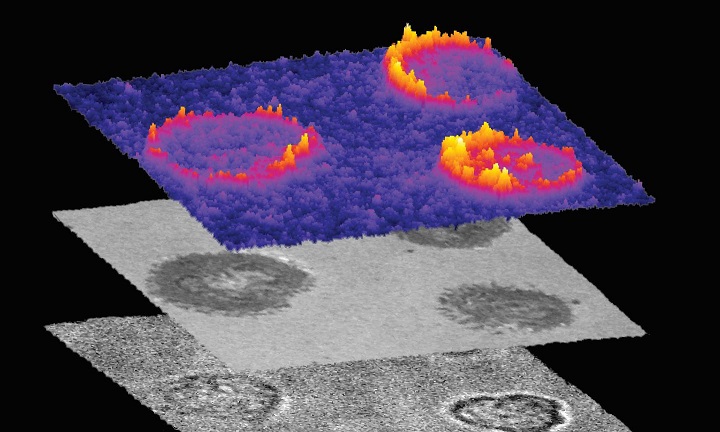T cells use 'handshakes' to sort friends from foes
T cells, the security guards of the immune system, use a kind of mechanical "handshake" to test whether a cell they encounter is a friend or foe, a new study finds.
The Proceedings of the National Academy of Sciences (PNAS) published the study, led by Khalid Salaita, a physical chemist at Emory University who specializes in the mechanical forces of cellular processes.
"We've provided the first direct evidence that a T cell gives precise mechanical tugs to other cells," Salaita says. "And we've shown that these tugs are central to a T cell's process of deciding whether to mount an immune response. A tug that releases easily, similar to a casual handshake, signals a friend. A stronger grip indicates a foe."
Salaita, from Emory's Department of Chemistry, collaborated on the research with Brian Evavold in the Emory School of Medicine's Department of Microbiology and Immunology.
T cells continuously patrol through the body in search of foreign invaders. They have molecules known as T-cell receptors (TCR) that can recognize specific antigenic peptides on the surface of a pathogenic or cancerous cell. When a T cell detects an antigen-presenting cell (APC), its TCR connects to a ligand, or binding molecule, of the APC. If the T cell determines the ligand is foreign, it becomes activated and starts pumping calcium. The calcium is part of a signaling chain that recruits other cells to come and help mount an immune response.
Scientists have known about this process for decades, but they have not fully understood how the T cell distinguishes small modifications to the antigenic ligand and how it decides to respond to it. "If you view this T cell response purely as a chemical process, it does not fully explain the remarkable specifity of the binding," Salaita says. "When you take the two components - the TCR and the ligand on the surface of cells - and just let them chemically bind in a solution, for example, you can't predict what will trigger a strong or a weak immune response."
The researchers hypothesized that mechanical strain might also play a role in a T cell response, since the T cell continues to move even as it locks into a bind with an antigenic ligand.
To test this idea, the Salaita lab developed DNA-based gold nanoparticle tension sensors that light up, or fluoresce, in response to a miniscule mechanical force of a piconewton - about one million-millionth the weight of an apple.
The researchers designed experiments using T cells from a mouse and allowed them to test ligands containing eight amino acid peptides that had slight mutations.
"We swapped out the fourth amino acid position to create really subtle chemical changes in the ligand that would be very difficult to distinguish without a mechanical component," Salaita says.
Some of the mutated ligands were given a firmer anchor to give them a tighter "grip" to the moving TCR.
Through the experiments, captured on microscopy video, the researchers were able to see, record and measure the responses of the T cells as they moved across the ligands.
"As a T cell moves across a cell's surface and encounters a ligand, it pulls on it," Salaita explains. "It doesn't pull very hard, it's a very precise and tiny tug that is not sustained. The T cell pulls and stops, pulls and stops, all across the surface. It's like the T cell is doing a mechanical test of the ligand."
During the experiments, the T cells did not activate fully when they encountered ligands with weak anchors. In contrast, when a T cell encountered a ligand with a firm anchor, the T cell became activated, showing that it experienced a piconewton level of resistance.
The amount of force that was applied by the T cell was mapped by using tension probes of different stiffness. Probes that responded to 19 piconewtons did not fluoresce, while softer, 12-piconewton probes produced high signal.
Following the fluorescence of the probe, the T cells switched on their calcium pumps and increased the calcium concentration within the cell, indicating that the T cell is mounting an immune response.
"We were able to map out the order of the cascade of chemical and mechanical reactions," Salaita says. "First, the T cell uses a very specific and finely tuned mechanical tug to distinguish friend from foe. And when it senses a precise, piconewton level of force in response to that tug, the T cell realizes that it has encountered a foreign body and gives the signal for attack."
The discovery could help in the search for treatments of auto-immune diseases and the development of immune therapies for cancer.
"Cancer cells have an extra molecule that can make T cell security guards 'drunk' or 'sleepy' so that they are not able to function properly," Salaita says. "Learning more about the mechanical forces involved in an effective immune response may help us develop ways to evade this defense system of cancer cells."
Source: Emory Health Sciences
http://www.biologynews.net/archives/2016/05/05/t_cells_use_handshakes_to_sort_friends_from_foes.html
BİOLOGY NEWS
-
RNA from Trained Aplysia Can Induce an Epigenetic Engram for Long-Term Sensitization in Untrained Aplysia.
-
HOW WE BECOME HAPPY
-
More tomatoes, faster: Accelerating tomato engineering
-
Purest yet liver-like cells generated from induced pluripotent stem cells
-
Legions of nanorobots target cancerous tumors with precision
-
CRISPR gene editing reveals new therapeutic approach for blood disorders
-
Quantum dots with impermeable shell: A powerful tool for nanoengineering
-
Thousands on one chip: New method to study proteins
-
Gene Drive Technology: Where is the future?
-
Four newly identified genes could improve rice
-
Watching the luminescent gene switch
-
DNA damage by ultrashort pulses of intense laser light
-
Mantis shrimp inspires next generation of ultra-strong materials
-
Specialized life forms abound at Arctic methane seeps
-
Ocean warming and acidification impact on calcareous phytoplankton



